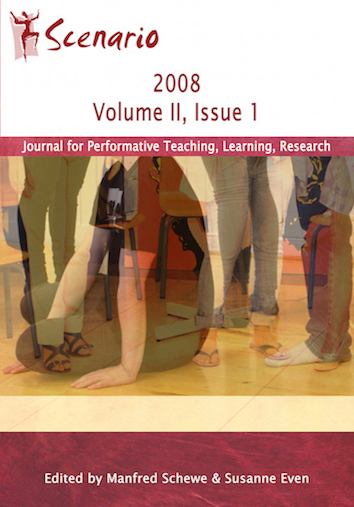Fitness for the Muscles and the Mind
DOI:
https://doi.org/10.33178/scenario.2.1.4Abstract
This paper describes the incorporation of a mind-body (fitness) technique called Nia into a drama-pedagogical teaching unit of Thomas Brussig’s novel Am kürzeren Ende der Sonnenallee. The participants were third year university students of German at McMaster University in Hamilton, Canada. The focus is on the description of the preparation and execution of a seven-hour weekend workshop on Brussig’s Sonnenallee. The ‘prerequisites’ for that workshop included research on life and resistance in the former German Democratic Republic (GDR) as well as a summary of the book and the production of character profiles for the main characters. The description of the workshop includes the portrayal of various activities such as the building of Standbilder (frozen frames), perception exercises und improvisations and, of course, the one-hour Nia session. According to the opinions of the students and my own experience and perception, drama-pedagogical elements and the inclusion of Nia have a great impact on the students’ understanding of various texts and themes and make for a truly holistic experience. This paper describes the incorporation of a mind-body (fitness) technique called Nia into a drama-pedagogical teaching unit of Thomas Brussig’s novel Am kürzeren Ende der Sonnenallee. The participants were third year university students of German at McMaster University in Hamilton, Canada. The focus is on the description of the preparation and execution of a seven-hour weekend workshop on Brussig’s Sonnenallee. The ‘prerequisites’ for that workshop included research on life and resistance in the former German Democratic Republic (GDR) as well as a summary of the book and the production of character profiles for the main characters. The description of the workshop includes the portrayal of various activities such as the building of Standbilder (frozen frames), perception exercises und improvisations and, of course, the one-hour Nia session. According to the opinions of the students and my own experience and perception, drama-pedagogical elements and the inclusion of Nia have a great impact on the students’ understanding of various texts and themes and make for a truly holistic experience.References
Brussig, Thomas (2004): Am kürzeren Ende der Sonnenallee (Easy Readers). Berlin: Klett
Chouinard, Philippe A./ Leonard, Gabriel / Paus, Tomáš (2006): Changes in effective connectivity of the primary motor cortex in stroke patients after rehabilitative therapy. In: Experimental Neurology 201 (2), 375-387
Cotman, Carl W. / Berchtold, Nicole C. / Christie, Lori-Ann (2007): Exercise builds brain health: key roles of growth factor cascades and inflammation. In: Trends in Neurosciences 30 (9), 464-472
Hollmann, Wildor / Struder, Heiko K. / Tagarakis, Christos V.M. / King, Gerald (2007): Physical activity and the elderly. In: European Journal of Cardiovascular Prevention & Rehabilitation. 14 (6), 730-739
Jung, Carl G. (1989): Memories, Dreams, Reflections. New York: Vintage Books Random House Inc
Kempe, Andy / Winkelmann, Ulrike (1998): Das Klassenzimmer als Bühne. Donauwörth: Auer
Lammers, Michael / Brussig, Thomas (2000): Interpretationshilfe Deutsch: Am kürzeren Ende der Sonnenallee. Interpretationshilfe Deutsch. (Lernmaterialien). Freising: Stark
McMaren, Leah (2003): "Fit for Duty" in Globe and Mail. July 26, F6
Scheller, Ingo (2004): Szenische Interpretation. Selze-Velber: Kallmeyer
Scheller, Ingo (1998): Szenisches Spiel. Handbuch für die pädagogische Praxis. Berlin: Cornelsen
Scheller, Ingo (1989): Wir machen unsere Inszenierungen selber I. Oldenburg: Zentrum für pädagogische Berufspraxis
Schweitzer, Natalie B. / Alessio, Helaine M. / Berry, Stephen D. / Roeske, Kirk / Hagerman, Ann E. (2006): Exercise-induced changes in cardiac gene expression and its relation to spatial maze performance. In: Neurochemistry International 48 (1), 9-16
Published
Issue
Section
License
Copyright (c) 2008 the author(s)

This work is licensed under a Creative Commons Attribution-NonCommercial-NoDerivatives 4.0 International License.







